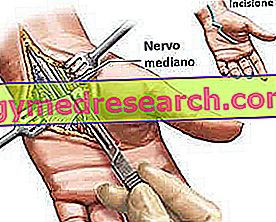Generality
Carpal tunnel surgery is the surgical procedure indicated for those suffering from a severe form of carpal tunnel syndrome. The purpose of the intervention is the decompression of the median nerve, obtained through a section of the carpal ligament located at the level of the wrist.

Figure: carpal tunnel open surgery. From the site: alessandrogildone.com
The procedure requires a certain preparation, it takes place under local anesthesia and can be done in two ways: in the open, that is by incising the skin for several centimeters, or in the closed sky, that is in arthroscopy.
Recovery times vary based on various factors, such as the type of procedure adopted, physiotherapy and daily work performed by the patient.
The results are satisfactory, although complications can sometimes arise.
Brief reminder of what carpal tunnel is
Carpal tunnel syndrome is a nervous compression syndrome ; in particular, it is characterized by the crushing of the median nerve at the level of the wrist, in correspondence of an osteo-ligamentous structure known precisely as carpal tunnel.
WHAT IS TUNNEL CARPALE?
The carpal tunnel is an arch-shaped osteo-ligament structure located between the inside of the wrist and the palm of the hand. Tunnel called vein because it forms a narrow passage for nine tendons and for a sensory and at the same time motor nerve, called the median nerve .
Laterally and posteriorly to the carpal tunnel, there are the bones of the hand, also called carpal bones .
What is carpal tunnel surgery?
Carpal tunnel surgery is the surgical procedure that allows decompression of the median nerve in patients with carpal tunnel syndrome. This result is obtained by making a small cut of the main ligamentous structure of the carpal tunnel, called the carpal ligament; in this way, by removing part of the ligament more space is given to the underlying elements (tendons and median nerve), avoiding the nervous crushing which is at the origin of the disorders typical of the syndrome in question.
The carpal ligament section is not definitive, as this structure, during the healing process, regenerates itself by adapting and "respecting" as much as possible the area occupied by tendons and median nerve. Therefore, the patient should not fear a permanent alteration of the wrist and its internal anatomy.
median nerve
The median nerve originates approximately at the level of the armpit, runs along the whole arm and, passing through the wrist, reaches the palm and fingers of the hand (excluding the little finger).
It has both a sensitive function, as it provides the tactile capabilities of the palm of the hand, and a motor function, as it allows the thumb, index, middle and part of the ring finger to be moved.
As shown by the figure, the median nerve passes through the carpal tunnel just below the main ligamentous structure.

When you run
Carpal tunnel surgery is performed when carpal tunnel syndrome is characterized by severe, intense symptoms, which are able to prevent normal daily activities and have been underway for at least 6 months.
BRIEF SUMMARY OF THE SYMPTOMS OF THE CARPAL TUNNEL SYNDROME
Carpal tunnel syndrome causes mainly tingling, numbness and pain at the wrist, palm and fingers.
This symptomatology is not sudden, but appears progressively; moreover, it tends to worsen during the night and when the affected joints are put under strong tension (for example, during strenuous manual activities that require repetitive flexion of the wrist).
Sometimes, other pains, such as:
- Dull pain in the forearm and arm
- Paresthesia of the affected limb (general tingling sensation associated with burning sensation)
- Dry skin, swelling, and skin color changes
- Hypoesthesia, or reduction of sensitivity
- Difficulty to bend the thumb
- Weakening of the muscles ( atrophy ) that govern the movement of the thumb
- Difficulty in gripping objects and performing certain manual actions, such as writing, typing text on a computer etc.
These manifestations, in the same way as the three main ones and always present, become more acute if the joints of the hand and wrist are continually placed in tension and bent in wrong positions.
Preparation
A few days before the operation, the medical team submits the patient to clinical tests to see if the patient is able to perform a surgical operation or not.
After that, he tells him how to present himself on the day of the surgery, what anesthesia is planned and how the procedure will take place.
CLINICAL FINDINGS
The investigations consist of: blood tests, blood pressure measurement, general health check and clinical history analysis (diseases suffered in the past, allergies to certain drugs, intolerance to certain anesthetics, previous surgical operations, etc.).
TYPE OF OPERATION
Carpal tunnel surgery is an outpatient type of surgery, therefore it is performed during the day and does not involve any hospitalization.
The discharge, however, occurs only after a few hours from the conclusion of the operation, as it is necessary to keep the patient under observation and see the response of this to the anesthetics used.
ANESTHESIA
The expected anesthesia is local . This means that the patient will be conscious at the time of surgery, but will not feel any pain in the wrist subjected to the operation.
The pre-operative meeting serves the medical team to illustrate to whom is going to undergo the surgical procedure, which are the anesthetic drugs used and which is the exact injection point.
HOW SHOULD YOU PRESENT IT ON THE DAY OF THE INTERVENTION?
On the day of carpal tunnel surgery, it is essential that the patient:
- Be present at full fast since at least the previous evening. Complete fasting is a purely precautionary measure, taken in the event that complications arise and general anesthesia is required.
- Present yourself accompanied by a family member or friend, as, at the end of the operation, you need help to return home. In fact, the effects of anesthesia and the after-effects of surgery can weaken or confuse the operated person.
Procedure
The patient is seated on a chair or on a couch and is asked to support the limb to be operated on a special support. Once this is done, the anesthesiologist injects the local anesthetic onto the wrist or hand and waits for the effect.
Once anesthesia has occurred, the surgeon intervenes, who can conduct the carpal tunnel operation in two different ways: through an " open sky " procedure or through a " closed sky " procedure. In the open air it means making an incision of several centimeters (even 3 or 4) at the level of the wrist; on the other hand, it means that the surgeon performs the surgery in arthroscopy or endoscopy .
The choice between proceeding in the open or in the sky is the exclusive responsibility of the doctor in charge.
INTERVENTION TO OPEN SKY
During the carpal tunnel operation in the open air, the surgeon performs a 3 or 4 cm skin incision at wrist level, more precisely between the hand and the wrist.
Then, it separates the skin flaps, uncovers the carpal ligament and dissects it in such a way as to decompress the median nerve.
Once the decompression procedure is completed, it closes the skin flaps and applies stitches, which can be absorbed or not reabsorbed.
INTERVENTION AT CLOSED HEAVEN IN ARTHROSCOPY OR ENDOSCOPY

Figure: closed surgery on the carpal tunnel, performed in endoscopy. From the site: sportsurgery.gr
During the operation to the carpal tunnel to closed sky, the surgeon can practice, on the wrist and / or in the palm of the hand, one or two skin incisions of the maximum size of one centimeter.
Through these small openings, thread the arthroscope (or endoscope) and surgical tools to dissect the carpal ligament and decompress the median nerve.
The arthroscope and the endoscope are two particular instruments, with similar characteristics: they are equipped with a camera, which, connected to a monitor, allows to see the internal cavity of the wrist and the carpal tunnel.
Once the main ligamentous structure is dissected and the arthroscope (or endoscope) and surgical tools are extracted, the surgeon closes the incisions made and applies stitches, which can be resorbable or non-absorbable.
Which of the two procedures is more invasive?
The open procedure, as can be seen from the description given above, is more invasive than the closed procedure. This greater invasiveness, however, allows a more effective action and greatly reduces the chances of a possible failure of the intervention.
Not surprisingly, when the surgeon encounters problems in performing the closed surgery, he interrupts the latter and goes to the open procedure.
DURATION OF THE OPERATION
Both the open procedure and the closed procedure last, except for complications, about 20 minutes .
IMMEDIATELY AFTER THE INTERVENTION
At the end of the surgery, the patient is taken to a hospitalization room and placed under precautionary observation for several hours.
It is important that, in the first post-operative phase, keep the arm raised about the height of the heart, in such a way as to prevent its possible swelling. In addition, he may need one or more administrations of anti-inflammatories and painkillers (usually paracetamol and ibuprofen).
As soon as the conditions are stable and the effects of local anesthesia have almost completely disappeared, the discharge of the operated person takes place with the family member or the accompanying friend.
What to do in case of acute pain?
If the patient feels a worsening of the pain sensation, it is advisable for him to communicate it to the health personnel, who, acting in consultation with the attending physician, will act accordingly.
From this it is easy to understand how important it is to have communicated, in the preparatory meeting for the intervention, the drugs to which there is an allergy or intolerance, to prevent them being administered involuntarily to relieve pain.
Healing times
Carpal tunnel surgery has several consequences. In fact, it weakens the strength of the hand and reduces the articular function of the wrist and fingers. For a complete recovery of these faculties, and for the healing of the dissected ligament, it takes several weeks, if not even months.
WHAT DOES THE RECOVERY PHASE DEPEND ON?
The post-operative phase depends on the following factors:
- The type of intervention . The cutaneous wound of the open surgery requires, to close again, several weeks more than the two small incisions of the closed procedure. If for the first it takes about 6 weeks, for the second it takes a few weeks.
- The care with which you follow the directions of the doctor and the physiotherapist . Scrupulously observing the doctor's advice and the physiotherapist's instructions allows you to recover joint function and hand strength in a shorter time.
- The work activity practiced . Manual work, especially if intense, slows down the healing time of the ligament and skin wounds. Therefore, the doctor advises to resume these work activities very carefully, paying attention to certain movements and observing brief periods of pause between one task and another.
Table. Overview of recovery times.
| Open intervention | Closed intervention | |
| Wound healing | 6 weeks | 1-2 weeks |
| Complete healing of the ligament | Maximum 8 weeks | Maximum 8 weeks |
| Return to work activities | 2 weeks, if the work done is not manual; | 1-2 days, if the work done is not manual and the hand is not the dominant hand |
| 6 weeks, if the work is manual | Maximum 4 weeks, if the work done is manual and the operated hand is the dominant one (that is, the habit hand used for any activity); | |
| Complete healing (intended as complete recovery of joint function and hand strength) | At least 3 months, as long as the instructions of the doctor and physiotherapist are followed and the operated hand is not overworked | 2-3 months, as long as you follow the advice of the doctor and the physiotherapist and that the operated hand is not overloaded with work |
PHYSIOTHERAPY
Physiotherapy plays a fundamental role for a correct recovery of joint function and muscle strength that governs the hand and wrist. This is why it is good to emphasize, once again, the importance of the indications of the physiotherapist and his rehabilitative exercises.
WHEN TO REMOVE THE SUTURE POINTS?
Resorbable stitches generally disappear after 7-10 days.
The non-absorbable stitches, on the other hand, are removed by the attending physician after 10-14 days.
Risks and complications
Carpal tunnel surgery is a safe procedure that provides excellent results. However, like any surgical operation, it too is not without risks and complications. In fact, it can involve:
- Strong and prolonged pain . Post-operative pain is usually tenuous and of short duration. However, in some unfortunate situations, it can persist for a long time and create different problems for the patient. When this happens, the painful area includes both the hand and the wrist.
- Obvious scars . The open-air operation is more likely to leave deep and evident skin signs.
- Sense of prolonged numbness . Numbness usually lasts a few weeks, but in some cases it can remain constant for several months. Often, in these circumstances, it is accompanied by severe pain.
- Infections . They are due to the entry of bacteria into the wound. To solve this problem, antibiotics must be administered to the patient. The main signs of an ongoing infection are: redness of the wound, loss of pus and high fever.
- Bleeding . Blood loss can occur during surgery, if the surgeon accidentally injures a blood vessel, or in the post-operative phase, if the patient hits the operated limb against an object.
- Permanent damage to the median nerve . During surgery, the attending physician may inadvertently damage the median nerve. The symptoms of this damage are: persistent sense of numbness and tingling. This is a rare possibility.
- Tendon damage . In these circumstances a second repairing surgery is needed. This is a rare possibility.
- Lack of strength in grasping objects and joint stiffness . Some patients have difficulty grasping objects, due to lack of strength or excessive joint stiffness. Generally, these circumstances resolve spontaneously, even if in rather long times.
- Recidivism . It is the reappearance of carpal tunnel syndrome. If the symptoms do not improve over several months, a second operation is required. It is, however, a very rare possibility.
Alternatives to intervention
If the symptoms of carpal tunnel syndrome are mild / moderate and have been ongoing for a short time, carpal tunnel surgery is excluded and other therapeutic treatments are chosen, such as:
- Wrist brace . It is generally used during the night to prevent the wrist from flexing and causing pain, tingling and numbness. The effects are not immediate, but you have to wait a few weeks. Therefore, patience is needed.
- Corticosteroids . Corticosteroids are powerful anti - inflammatory drugs, which can be administered either by mouth or by a local injection in the painful wrist. Their prolonged use can have serious side effects, such as hypertension, osteoporosis, weight gain, etc. Therefore, if the treatment does not take effect, it is advisable to ask the doctor for advice about what to do.
Results
Although they have different recovery times, both the open and closed procedure are safe and effective surgical operations. According to Anglo-Saxon statistics, in fact, more than half of the patients who underwent carpal tunnel surgery recovered satisfactorily, without recurrence.



